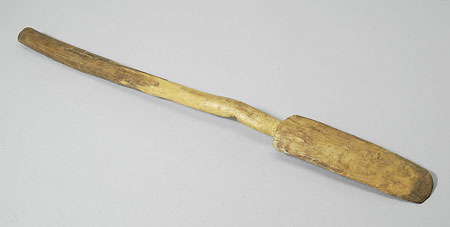Accession Number:
1936.10.29
Country:
Sudan
Region:
[Southern Sudan]
Cultural Group:
Anywaa [Anuak]
Date Made:
By 1936
Materials:
Wood Plant
Process:
Carved
Dimensions:
Total L = 672; blade L = 210, W = 64, max th = 20; handle diam = 32.4 x 29.5 mm [RTS 16/8/2005].
Weight:
312.2 g
Local Name:
abaya
Other Owners:
Presumably collected by Evans-Pritchard during his period of fieldwork amongst the Anuak between early March and May 1935 [RTS 18/6/2004].
Field Collector:
Edward Evan Evans-Pritchard
PRM Source:
Edward Evan Evans-Pritchard
Acquired:
Donated 1936
Collected Date:
March - May 1935
Description:
Hoe carved from a single piece of wood, and consisting of a narrow rectangular blade with curved end, slightly concave upper surface and convex underside; this thins to form cutting edges at the end and down either long side, and thickens at its shoulders where it joins with a cylindrical handle.
The handle is slightly irregular, following the natural shape and flaws in the wood.
Shaving marks are visible down its sides.
There is some polish on the handle end, which is a mid brown colour (Pantone 7505C), while further up the shaft the yellowish colour of the subsurface wood has been exposed (Pantone 7509C).
The hoe is complete and intact, with a weight of 312.2 grams.
It is 672 mm long, with a blade length of 210 mm, width of 64 mm and maximum thickness of 20 mm; the handle shaft has a diameter of 32.4 by 29.5 mm.
Presumably collected by Evans-Pritchard during his period of fieldwork amongst the Anuak between early March and May 1935 (E.E. Evans-Pritchard, 1940, The Political System of the Anuak of the Anglo-Egyptian Sudan, p. 3).
This hoe was made specifically for Evans-Pritchard; it is known to the Anuak as abaya, and is an obsolete type of hoe that was in general use before iron was introduced.
Evans-Pritchard mentions this type of object in his book on the Anuak: 'In old times iron hoes did not exist and wooden hoes (abaya) are still sometimes used today.' (E.E. Evans-Pritchard, 1940, The Political System of the Anuak of the Anglo-Egyptian Sudan, p. 56 note 1). Similar hoes were also used by the Dinka and Acholi (see R. Boccassino, 1963, "Contributo allo studio dell'ergologia delle popolazioni nilotiche e nilo-camitiche Parte Terza", Annali Lateranensi XXVII, fig. 91 (right) and fig. 93a).
Rachael Sparks 30/9/2005.
Presumably collected by Evans-Pritchard during his period of fieldwork amongst the Anuak between early March and May 1935 (E.E. Evans-Pritchard, 1940, The Political System of the Anuak of the Anglo-Egyptian Sudan, p. 3).
This hoe was made specifically for Evans-Pritchard; it is known to the Anuak as abaya, and is an obsolete type of hoe that was in general use before iron was introduced.
Evans-Pritchard mentions this type of object in his book on the Anuak: 'In old times iron hoes did not exist and wooden hoes (abaya) are still sometimes used today.' (E.E. Evans-Pritchard, 1940, The Political System of the Anuak of the Anglo-Egyptian Sudan, p. 56 note 1). Similar hoes were also used by the Dinka and Acholi (see R. Boccassino, 1963, "Contributo allo studio dell'ergologia delle popolazioni nilotiche e nilo-camitiche Parte Terza", Annali Lateranensi XXVII, fig. 91 (right) and fig. 93a).
Rachael Sparks 30/9/2005.
Primary Documentation:
Accession Book Entry
[p.
410] - 1936 [insert] 10 [end insert] E.
EVANS-PRITCHARD, M.A., Exeter College, Oxford.
- Specimens collected by himself in the EASTERN SUDAN, while travelling with a Grant from the
Rockefeller
Leverhulme Trustees, viz: [p.
412] [insert] 29 [end insert] -
Abaya
, obsolete type of wooden, spade-like hoe, used before iron was introduced.
(Made for E[dward].E[vans]-P[ritchard]).
ANUAK.
Card Catalogue Entry - There is no further information on the catalogue card [RTS 30/1/2004].
Pitt Rivers Museum label - AFRICA, Sudan. ANUAK Tribe. Wooden hoe, abaya . d.d. E. Evans-Pritchard, 1936.10.29 [plastic coated label, tied to object; RTS 16/8/2005].
Written on object - Abaya , obsolete type of hoe used before iron was introduced. ANUAK. E. SUDAN. d.d. E.Evans-Pritchard, 1936 [RTS 16/8/2005].
Card Catalogue Entry - There is no further information on the catalogue card [RTS 30/1/2004].
Pitt Rivers Museum label - AFRICA, Sudan. ANUAK Tribe. Wooden hoe, abaya . d.d. E. Evans-Pritchard, 1936.10.29 [plastic coated label, tied to object; RTS 16/8/2005].
Written on object - Abaya , obsolete type of hoe used before iron was introduced. ANUAK. E. SUDAN. d.d. E.Evans-Pritchard, 1936 [RTS 16/8/2005].





